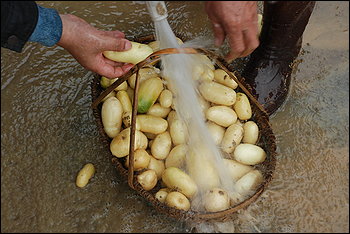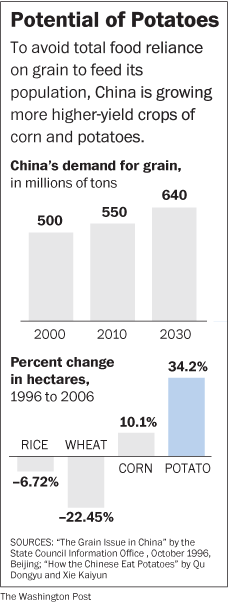The Chinese take a page from my Irish ancestors
 Wednesday, June 16, 2010 at 12:06AM
Wednesday, June 16, 2010 at 12:06AM  WAPO story.
WAPO story.
The gist:
The Chinese government has begun ramping up research, production and training related to the humble spud, and hopes are high that it could help alleviate poverty and serve as a bulwark against famine.
The challenge of feeding a growing nation on a shrinking supply of arable land while confronting severe water shortages has long been a major concern here. China has to feed one-fifth of the world's population on one-tenth of its arable land, and the nation's expanding cities are consuming farmland at breakneck speed. China estimates that by 2030, when its population is expected to level off at roughly 1.5 billion, it will need to produce an additional 100 million tons of food each year.
That statistical reality could change eating habits here. Potatoes need less water to grow than rice or wheat, and they yield far more calories per acre.
 Makes you wonder why the Irish got so heavy into potatoes, because there's no shortage of water there. Must be the tough growing season.
Makes you wonder why the Irish got so heavy into potatoes, because there's no shortage of water there. Must be the tough growing season.
But the pattern is clear enough: cut back on water-intensive crops and move into more hardier fare (rice to potatoes). Obviously, rice isn't going anywhere, but as one Chinese ag expert put it, "Rice, wheat, corn -- we've gone about as far as we can go with them. But not the potato."
Some perspective on this shift: China actually ALREADY produces and consumes more potatoes than any other in the world. But when it comes to consumption, because we're talking such a huge population, the Chinese lag in per capita terms, eating only one-third the amount of potatoes that Russians do and two-thirds the amount Americans eat.
If I could get every Chinese to eat a potato a day . . ..










Reader Comments (4)
One reason that "the Irish got so heavy into potatoes" is that the crop does not take an awful lot of work. Not to imply that the Irish were lazy. On the contrary, they spent most of their time working for absentee landlords. Potatoes (which do well under wet conditions, despite what is being said about needing less water) were a great crop, requiring a burst of activity in the spring, to plant the tubers, and another one in the autumn, to harvest them. More calories not only per acre, but also per hour of effort.
I think I read or heard somewhere (I know, not exactly a great citation to authority) that a lot of the other crops and animal products were exported out regardless of local need and potatos were not exported out so much. If so, potatos might also be what they were left with to eat by default. Potatos can also be prepared for eating pretty fast right out of the ground as compared to grains which need a lot of work to become bread or gruel or whatever.
What about soybeans? Grow very well in very dry land. More protein per acre than meat, by far. Sybeans + Potatoes = complex carbs. For cultural reasons, India never embraced the noble soybeans, still get most of their protein from dairy.
The heck with soybeans. I want the McDonald's franchises! A potato a day, that's all they ask.